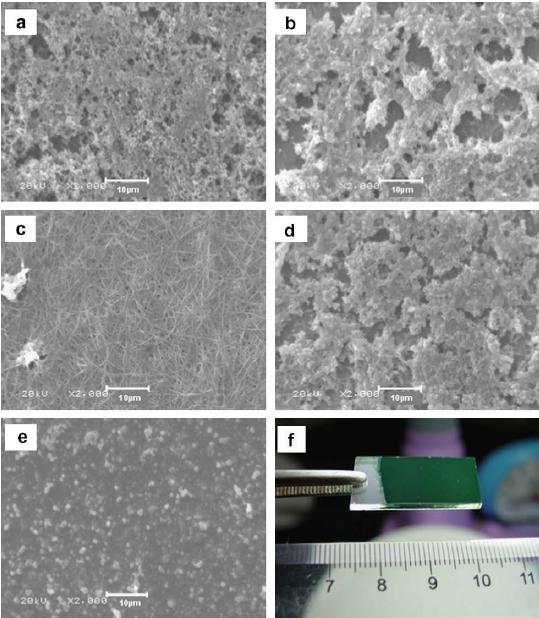The in situ electropolymerized-polyaniline (PANI) film (thickness: 5–20 μm) on FTO (fluorine tin oxide) glass doped by various counterions SO42_ , ClO4_, BF_4 , Cl−, p-toluenesulfonate (TsO−), etc. was prepared with electropolymerized charge capacity of 50–600 mC cm-2. Different doping counterions have great impact on the morphology, electrochemical activity of electropolymerized-PANI film. The electropolymerized-PANI doped by SO42_ anion (PANI-SO4) film with much porous morphology and pore size diameter of several micrometers possesses higher reduction current for reduction of I_3 and a low charge-transfer resistance of 1.3 Ω cm2 in comparison with Pt as counter electrode (CE). Dye-sensitized solar cell with PANI-SO4as CE was assembled, and the device under full sunlight illumination (100 mW cm-2, AM 1.5 G) shows 5.6% photovoltaic conversion efficiency, which is comparable to 6.0% of that with Pt CE under the same experimental condition.
In summary, the PANI-SO4 film with much porous morphology and the pore size diameter of several micrometers possesses higher reduction current for reduction of I_3 and a low charge-transfer resistance of 1.3 Ω cm2 in comparison with Pt as CE. 5.6% power conversion efficiency at full sunlight and good cell stability has been achieved for DSSC based PANI-SO4 as CE incorporating a photoanode prepared by commercial P25 TiO2. The facile electrochemical preparation procedure, comparable photovoltaic properties and very low cost allow PANI electrode to be an alternative CE used in low cost DSSCs.
Electrochemistry Communications 11 (2009) 1768–1771
Corresponding author: Deng, YQ, Chinese Acad Sci, Lanzhou Inst Chem Phys, Ctr Green Chem & Catalysis, Lanzhou 730000, Peoples R China
E-mail address: ydeng@lzb.ac.cn
Click here to view full the text.

SEM morphologies of (a) PANI-SO4, (b) PANI-ClO4, (c) PANI-BF4, (d) PANI-Cl, (e) PANI-TsO with electropolymerized charge capacity of 400 mC cm-2, and (f) a picture of PANI-SO4 film
|

